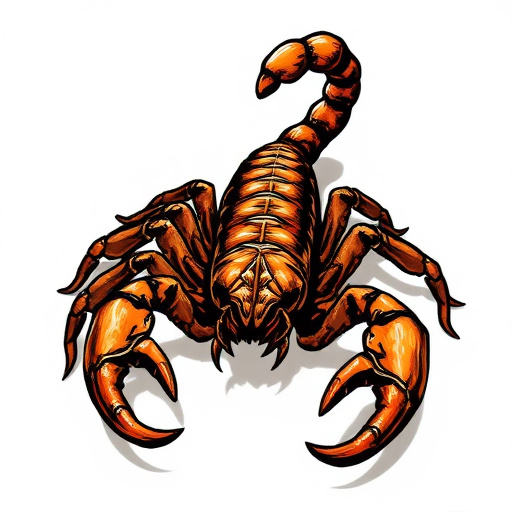Tucson's diverse scorpion population includes species like the desert scorpion (Leiurus quinquestriatus) and brown violin scorpion (Androctonus australis). Effective scorpion control Tucson requires understanding their behavioral patterns, habitat preferences, and implementing targeted measures. This involves public awareness, proactive prevention (e.g., waste management), sealing entry points, professional pest control services, and regular inspections. While stings are usually not life-threatening, immediate first aid is recommended for severe reactions or persistent pain. Tucson residents can manage infestations through clean environments, removing hiding spots, using natural repellents, sticky traps, and tailored chemical applications.
“Tucson, with its diverse ecosystems, plays host to a variety of scorpion species. This article offers a comprehensive overview of the most common scorpions found in the area, providing crucial insights into their identification, behavior, and habitat preferences. We explore potential health risks associated with scorpion stings and offer first aid measures. Additionally, effective scorpion control strategies tailored for Tucson residents are discussed, highlighting practical steps to mitigate these arachnids’ presence.”
- Common Scorpion Species in Tucson: An Overview
- Identifying the Local Scorpion Populations
- Understanding Their Behavior and Habitat
- Potential Health Risks and First Aid Measures
- Effective Scorpion Control Strategies for Tucson Residents
Common Scorpion Species in Tucson: An Overview

Tucson, Arizona, is home to a variety of scorpion species, making it essential for residents and visitors alike to understand these arachnid neighbors. Among the most common are the Leiurus quinquestriatus, commonly known as the desert scorpion, and Androctonus australis, the brown violin scorpion. These species have adapted to the region’s arid climate and are often found in residential areas, gardens, and even indoors.
Scorpion control Tucson is a growing concern due to their presence in urban environments. The desert scorpion is easily recognizable by its yellowish-brown color and distinctive stinger. While usually solitary and nocturnal, they can become aggressive if threatened or disturbed. The brown violin scorpion, on the other hand, has a striking appearance with a dark brown body and a lighter, violin-shaped pattern on its back. It prefers drier, more secluded habitats within homes and structures. Understanding these species’ behaviors and habitats is crucial for implementing effective scorpion control measures in Tucson.
Identifying the Local Scorpion Populations

Tucson, with its unique desert ecosystem, is home to a variety of scorpion species. Identifying these local populations is crucial for both understanding the region’s biodiversity and implementing effective scorpion control measures. The most common scorpions found in Tucson include species like the Desert Hairy Scorpion (Androctonus australis) and the Mountain Scorpion (Uroplectes melanurus). These species have adapted to the arid conditions, making them prevalent in the area’s scrublands and mountainous regions.
Scorpion control in Tucson involves a combination of prevention and management strategies. Locals and visitors alike should be aware of these common species to avoid stings and minimize populations. Regular inspections, proper waste management, sealing entry points, and using professional pest control services are essential tactics for scorpion control in Tucson. By understanding the local scorpion populations and implementing these measures, residents can better protect their homes and communities from these arachnids.
Understanding Their Behavior and Habitat

Scorpis, often seen as menacing creatures, play a crucial role in Tucson’s ecosystem. Understanding their behavior is key to effective scorpion control Tucson residents and visitors alike may require. Many species prefer dry, rocky habitats, often burrowing under ground or hiding in crevices during the day to avoid extreme temperatures. They become more active at night when they hunt for prey, including insects, spiders, and even small rodents. Their territorial nature means they tend to avoid human contact unless provoked or cornered.
Knowing their habitat allows for better prevention strategies. Maintaining a clean yard by eliminating clutter, sealing entry points, and keeping vegetation trimmed reduces attractions for scorpions. Regular scorpion control Tucson services can also help manage populations. Professional treatments target areas where scorpions are likely to hide, disrupting their life cycles and reducing their presence in residential areas.
Potential Health Risks and First Aid Measures

Scorpions, despite their intimidating appearance, rarely pose a significant health risk to humans. However, their stings can be painful and, in some cases, dangerous, especially for children, the elderly, or individuals with specific medical conditions. The most common scorpion species in Tucson, like the Black-tailed Scorpion, are generally not life-threatening but can cause severe local pain and swelling. In rare instances, certain species’ venom may lead to systemic symptoms such as nausea, dizziness, or difficulty breathing.
If stung by a scorpion in Tucson, it’s crucial to take immediate first aid measures. Wash the wound with soap and water to reduce bacteria spread. Applying ice can help alleviate pain and swelling. For severe reactions, such as difficulty breathing or persistent pain, seek medical attention promptly. Over-the-counter pain relievers like ibuprofen can manage discomfort. Most importantly, when dealing with scorpion encounters or potential stings, consider professional scorpion control services in Tucson to ensure safe and effective management of these arachnids.
Effective Scorpion Control Strategies for Tucson Residents

In the face of persistent scorpion infestations, Tucson residents have several effective strategies at their disposal for scorpion control. One crucial approach is maintaining a clean and sealed environment. Scorpions thrive in dark, narrow spaces, so regular cleaning and sealing entry points like cracks, gaps around pipes, and windowsills can significantly deter them. Additionally, removing potential hiding spots such as excessive vegetation and clutter from around the house creates an inhospitable environment for scorpions.
For more targeted scorpion control Tucson solutions, professional pest control services offer safe and effective treatments. These professionals utilize a combination of natural repellents, sticky traps, and tailored chemical applications to address specific scorpion species prevalent in the area. Regular inspections are also vital; identifying scorpion activity early allows for swift intervention, preventing populations from establishing and spreading.
Tucson’s diverse ecosystem plays host to several common scorpion species, each with its unique behavior and habitat preferences. Understanding these variations is crucial for both residents and visitors alike, especially regarding potential health risks. By identifying local scorpion populations and implementing effective scorpion control strategies, such as sealing entry points, maintaining cleanliness, and seeking professional assistance when needed, Tucson residents can significantly reduce the occurrence of stings and ensure a safer environment. Remember, with proper knowledge and proactive measures, scorpion control in Tucson is achievable while preserving the city’s unique natural balance.
